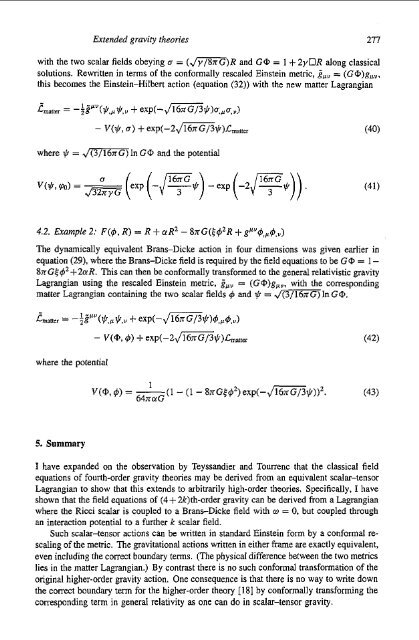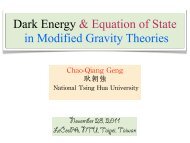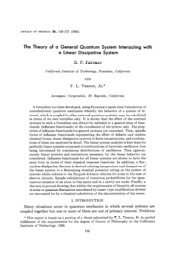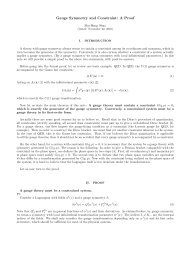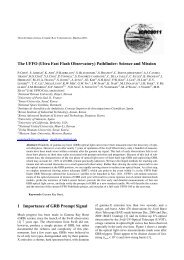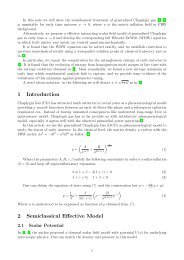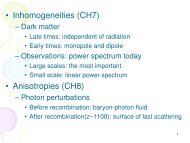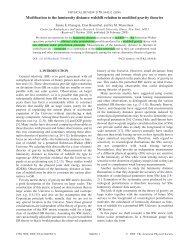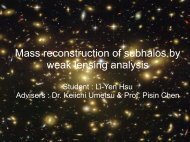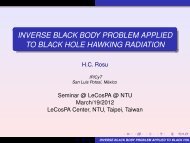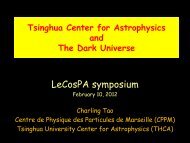Extended gravity theories and the Einstein--Hilbert action
Extended gravity theories and the Einstein--Hilbert action
Extended gravity theories and the Einstein--Hilbert action
You also want an ePaper? Increase the reach of your titles
YUMPU automatically turns print PDFs into web optimized ePapers that Google loves.
<strong>Extended</strong> graviry <strong><strong>the</strong>ories</strong> 211<br />
with <strong>the</strong> two scalar fields obeying U = ( m ) R <strong>and</strong> GO = 1 + 2yOR along classical<br />
solutions. Rewritten in terms of <strong>the</strong> conformally rescaled <strong>Einstein</strong> metric, 2,” = (G??)g,,.<br />
this becomes <strong>the</strong> <strong>Einstein</strong>-<strong>Hilbert</strong> <strong>action</strong> (equation (32)) with <strong>the</strong> new matter Lagrangian<br />
4.2. Example 2: F(4, R) = R + orR2 - SXG(~~’R + g””q5s@,u)<br />
The dynamically equivalent Brans-Dicke <strong>action</strong> in four dimensions was given earlier in<br />
equation (29), where <strong>the</strong> Brans-Dicke field is required by <strong>the</strong> field equations to be GO = 1 -<br />
8nG:C2+2aR. This can <strong>the</strong>n be conformally transformed to <strong>the</strong> general relativistic <strong>gravity</strong><br />
Lagrangian using <strong>the</strong> rescaled <strong>Einstein</strong> metric, = (GO)g@”, with <strong>the</strong> corresponding<br />
matter Lagrangian containing <strong>the</strong> two scalar fields 4 <strong>and</strong> * = J m l n G O .<br />
where <strong>the</strong> potential<br />
5. Summary<br />
I have exp<strong>and</strong>ed on <strong>the</strong> observation by Teyss<strong>and</strong>ier <strong>and</strong> Tourrenc that <strong>the</strong> classical field<br />
equations of fourth-order <strong>gravity</strong> <strong><strong>the</strong>ories</strong> may be derived from an equivalent scalar-tensor<br />
Lagrangian to show that this extends to arbitrarily high-order <strong><strong>the</strong>ories</strong>. Specifically, I have<br />
shown that <strong>the</strong> field equations of (4+ 2k)th-order <strong>gravity</strong> can be derived from a Lagrangian<br />
where <strong>the</strong> Ricci scalar is coupled to a Brans-Dicke field with w = 0, but coupled through<br />
an inter<strong>action</strong> potential to a fur<strong>the</strong>r k scalar field.<br />
Such scalar-tensor <strong>action</strong>s can be written in st<strong>and</strong>ard <strong>Einstein</strong> form by a conformal re-<br />
scaling of <strong>the</strong> metric. The gravitational <strong>action</strong>s written in ei<strong>the</strong>r frame are exactly equivalent,<br />
even including <strong>the</strong>correct boundary terms. (The physical difference between <strong>the</strong> two mebics<br />
lies in <strong>the</strong> matter Lagrangian.) By contrast <strong>the</strong>re is no such conformal transformation of <strong>the</strong><br />
original higher-order <strong>gravity</strong> <strong>action</strong>. One consequence is that <strong>the</strong>re is no way to write down<br />
<strong>the</strong> correct boundary term for <strong>the</strong> higher-order <strong>the</strong>ory [18] by conformally transforming <strong>the</strong><br />
corresponding term in general relativity as one can do in scalar-tensor <strong>gravity</strong>.


